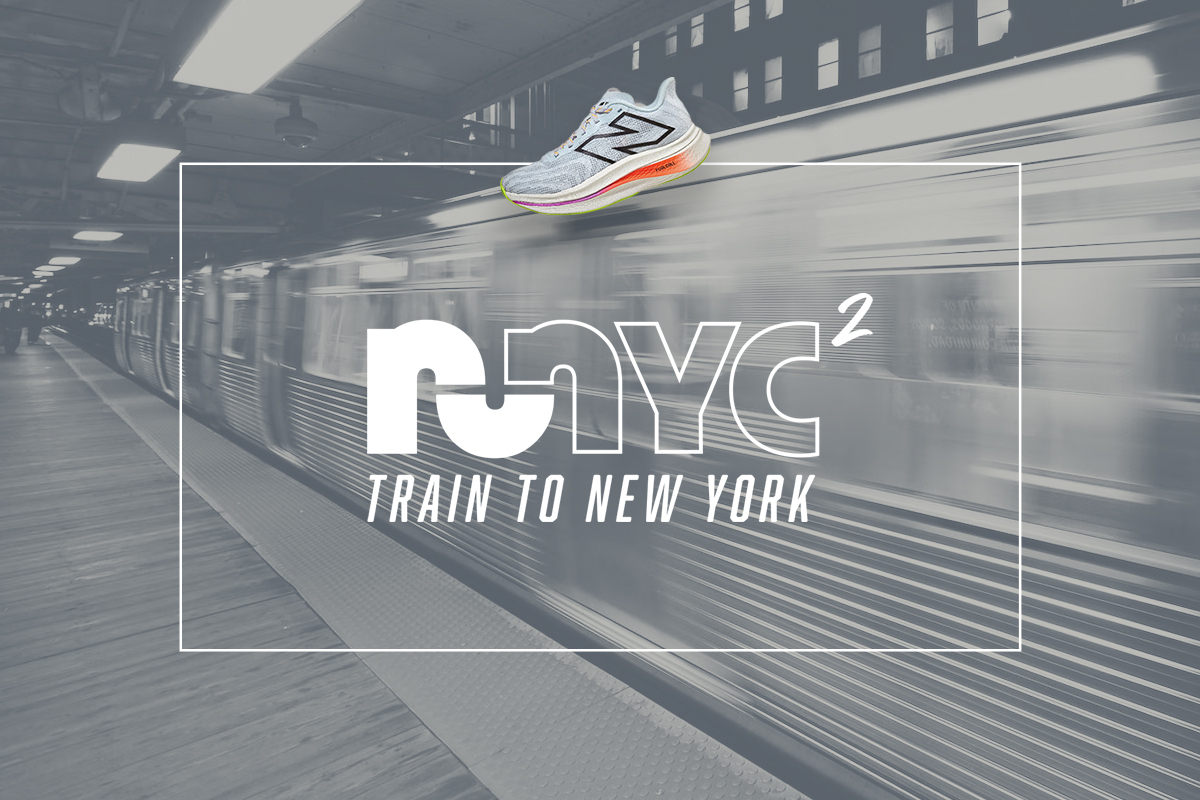
We independently review everything we recommend. When you buy through our links, we may earn a commission.
Short-distance mountain race series, started by mountain athlete Julian Carr
Run straight up a mountain and back, then have a party
Trail reviewers Taylor and Michael recap the Arapahoe Basin race
A clean line is something that skiers and climbers know really well. Achieving one is both artistic and athletic, going from point A to point B in a simple “from here to there” way. Like a perfect brushstroke on a clean canvas, it’s a particular and pleasing aesthetic.
This mindset is the juncture at which the Cirque Series, a premier mountain running series, was born.
For those thigh-deep in the world of powder, race director Julian Carr needs no introduction. X-Games gold medalist and world record holder for the longest cliff drop on skis (210 feet), Carr is known for dreaming up grand escapades. Living in Utah in the early 2010’s, Carr frequently ran nearby Mt. Olympus. It was a short distance, not ultra worthy, but challenging nonetheless. Most of all, it was fun. Carr found himself wanting to run more distances like this, something like a 7-mile race with 3,000-4,000 feet of vertical ascent. The problem? That kind of race didn’t exist. Not in Utah, or anywhere else in the United States.

Running the ridge in Arapahoe Basin (photo credit Ian Zinner)
Sticking to the “if you build it, they will come” mantra, Carr started the Cirque Series in 2013, which has now expanded into seven races: five in the western United States, one in Alaska, and a series finale in Switzerland. The events are staged at ski resorts, a no-brainer thanks to their built-in infrastructure to support lots of people, purposeful safety plans, and desirable terrains.
All are relatively short by trail running standards, between 6 and 9.5 miles. But what they lack in distance, they make up for in height. By running a roundtrip route from the base of a ski area to a high point and back, each race manages to cram in somewhere between 2,000-4,000 feet of vert along the way.
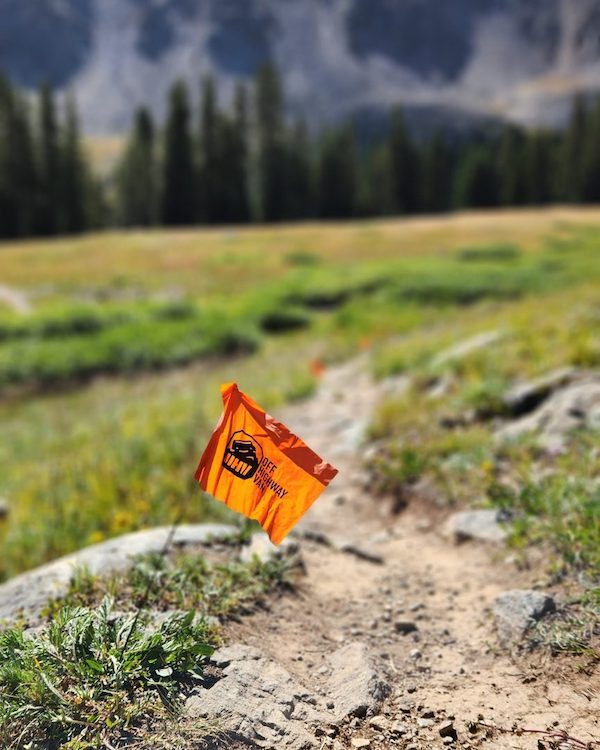
Trail marker

Climbing up (photo credit Keith Fearnow)
As you may imagine, this short-but-hard design makes for some high-octane racing. Prize payouts in the form of cash and gear (a rarity in short distance trail races) help keep the competition lively as well, with the top winner in the pro field taking home a $1,000 paycheck in 2023. The Cirque Series is unique in that it offers three categories (Sport, Expert, and Pro) with equal prize payouts per men’s and women’s podiums.
With three divisions, runners of all abilities are encouraged to register and compete, from a beginner trail runner to a seasoned pro. Sport is for the athlete with limited experience on trails or mountain terrain, who typically sign up for fun or the challenge of it. Expert is for experienced trail runners who are well-versed in mountain travel. Pro is for elite trail runners seeking that prize purse.
The bigger reason for providing categories is to encourage all abilities to register. Sport is for the athlete who has very little or no experience being in mountain terrain or on trails and are Whether you take one hour or half the day to traverse these courses, it doesn’t matter. The Cirque Series is set up for everyone to push their individual boundaries up, down, and around these mountainous landscapes… and to party at the end! As you’ll find in Michael’s race report below, the pre- and post-race environment is one-of-a-kind for a trail race. That’s a purposeful element too.

Participants can wear test On trail shoes for the race
Like its presenting sponsor On, the Cirque Series has grown dramatically since its ideation phase. Both the series and the brand have developed their identities along parallel tracks, creating a seamless dovetail of a partnership. As for the future of the Cirque Series, there’s really only one thing for certain: it’s going to keep growing. Trail running often feels inaccessible, especially as it has trended towards longer and longer distances over the past decade.
Expansion isn’t necessary for the success of the event and slow growth has worked well for the series. But Carr has found himself sorting through plenty of inquiries when planning for future events. (Editor’s note: as an East Coaster, I’m begging you to bring it out here for some gnarly vert on Northeast terrain).
Carr isn’t moving too quickly on any of these events yet. I asked him about his goals for the series. “As far as I envisioned them, we’re there,” he responded.
Contentment and quality are a hard marriage to sustain, especially as popularity takes hold. Where many would push all-in on the lucrative bet, Carr is content to follow his core ethos and give people the experience he originally wanted (and continues to provide) with the series.
Having now experienced one of the events as a spectator (thank you, broken foot), I can guarantee you two things: 1) The experience is everything that Julian has described, and 2) I’ll be coming back to race.

Julian Carr giving pre-race announcements (photo credit Keith Fearnow)

Steven Tyler loves this arch (photo credit Keith Fearnow)
Now that you’ve learned about the background of the Cirque series itself, you might find yourself wondering: “What’s it like to actually run these things?” Or, if you’re sitting on the East Coast: “Is it actually worth flying out west for a weekend to try one of these things?”
As a member of the trail team, an invitation was extended my way (courtesy of On) for an entry to the Cirque Series race in Arapahoe, Colo., on September 9. I’m from Alabama, so I had yet to experience an actual trail race in Colorado.
I quickly rearranged my work schedule and cashed in some accumulated airline miles from my day job, and booked a flight to Denver (the one-world airport itself). On sent some shoes and gear to test out for the race, so I was ready to roll.
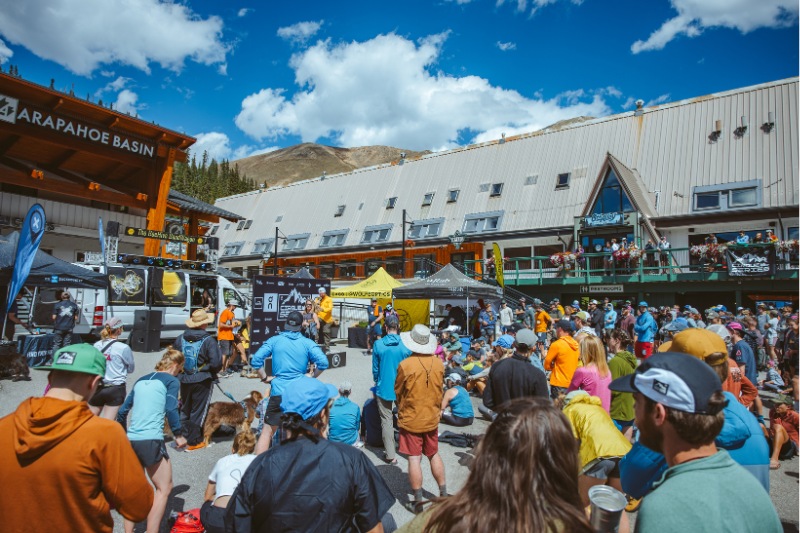
Traveling with my wife Mary, we were beyond excited to visit Colorado, hang out with Taylor and get to try out an entirely new and exciting race format. You see, in ‘Bama, there just aren’t many extended climbs, so the idea of continuously gaining vert for what looked to be a proper hour was going to be a totally unique and exciting experience– as was the altitude.
With just four weeks of training leading up to the race, I pretty much hit the StairMaster as much as I could, and ran a handful of long runs in the thick, Southern humidity (poor man’s altitude training, right?). All that to say, I put in as much training as I could in the little time I had. Undercooked is better than overcooked, right? At least that’s what I like to tell myself.
The good news is that while my training may have been questionable, my gear for the race wasn’t. After receiving both the Cloudultra 2 and Cloudventure Peak 3 from On, it quickly became clear which model would be suited for this event. The Peak 3 sports a durable, lightweight construction with an ultra-precise fit, a thin midsole of Helion foam with a rock plate for protection, and maybe best of all– an undyed white colorway.
From the first training run, it became clear this shoe was built for some fast racing on technical terrain, and would ultimately prove to be an excellent choice for the course. Without spoiling too much, by the end of the race I really fell in love with the shoe. The rock plate proved to be a lifesaver while bombing downhills, and the lockdown was entirely solid, a must-have feature for throwing down on technical descents. Going uphill, the shoe really flew up the climbs, reminding me of a cross-country spike with its lightweight build. Like the Hoka Zinal 2, this shoe makes running uphill legitimately exhilarating.
With all the gear choices, travel plans, and some “training” in place, all that’s left was to enjoy the experience. The day before the race, Mary and I arrived in Colorado exhausted from the week’s work (not to mention the hassle of Atlanta traffic, missed flights, and delays), but excited for what lay ahead. After some sightseeing and packet pickup in Boulder, we caught a ride with Taylor back to the unbelievably beautiful Estes Park. Like a wide-eyed kiddo on Christmas eve, I found it difficult to sleep, dreaming of the vert and views that would come in the morning.

On Cloudventure Peak 3 for race day
On race morning, Taylor asked us if we wanted to take the scenic route to the venue. Of course we said yes, and we were treated to an absolutely breathtaking sunrise drive through Rocky Mountain National Park. I won’t go on forever here (this is a race report, after all), but just know that sometimes the travel to the race can be its own incredible adventure. We saw (and heard!) elk, smelled evergreen pines, enjoyed good coffee and conversation together, and gazed at an alpenglow slowly covering the mountainsides like a warm blanket.
Upon arrival at the venue, things felt surprisingly normal… there were parked cars, some lines for the bathroom, some running around looking for safety pins– you know the gig. However, as race time approached, you could feel the excitement build. Everyone was smiling, and as racers warmed up, so did the mountain. The chilly morning air began to shift to a lovely 50-ish degrees, a dream climate for all runners everywhere.
During my warmup, I could feel the welcoming atmosphere of this place– smiles and encouragement were exchanged everywhere. After I finally found those safety pins, I made my way to an absolutely massive group of runners lining up in the start corral, all mentally preparing for an all-out assault on the mountain. It was go-time.
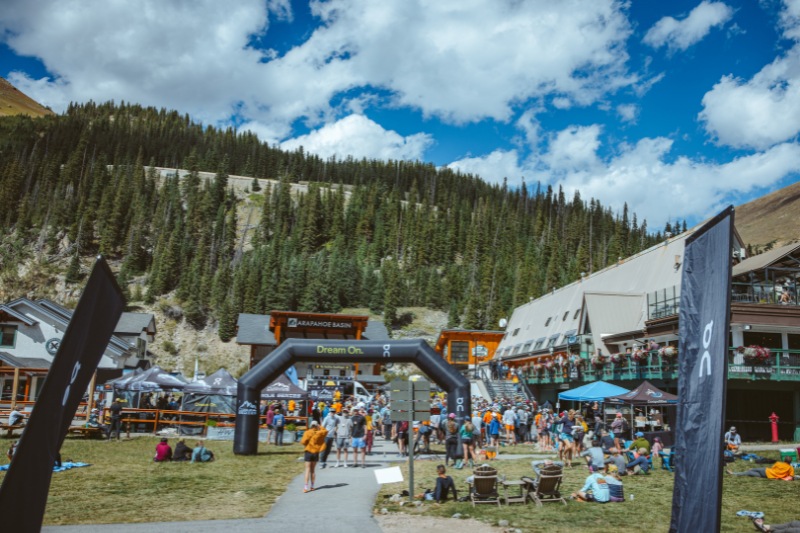
Backdrop of the start and finish line (photo credit Keith Fearnow)
The Cirque series start line atmosphere is properly electric, and unlike anything I’ve ever experienced at a trail race. Even with a 12,500 foot-peak looming overhead, the energy, excitement, and joy of 600 runners ready to go full-gas actually lowered my pre-race nerves.
Typically when I get pre-race nerves I can talk myself down quickly. I try to consciously trust my fitness, remind myself of the old adage “if you run with joy you can’t lose,” and remember that no matter what happens my wife and friends will still be at the finish line… smiling, and proud of me. While all that was true at the Cirque series start line, I also felt that the runners around me were encouraging in their own, silent way. The overwhelming feeling was something like “Hey Michael, you can do this… we can do this”. No matter how physically ready I was, I was so mentally ready to go rip up the mountain in front of me and enjoy a beautiful day out there.

Start ’em up!

Working the presses (photo credit Keith Fearnow)
After the gun went off, I found myself moving quickly through the race on the first bits of fire road ascent. Of course, having only been in Colorado for a day, I wasn’t exactly acclimated to the altitude, and the first 10 minutes of the climb really took some getting used to. After I found my sweet spot, I told myself to continue moving up in the pack, and ultimately found myself climbing about 10 seconds behind Tabor Hemming, a professional short course athlete from Kremmling, Colorado. I figured she would be a great person to pace the climb with, and I decided I would try to keep close if my legs and lungs could keep up.
For the rest of the climb, I tried to not think about the summit, choosing to enjoy the little challenges that lay directly in front of me– controlling my breathing, getting to the next switchback, that sort of thing. As the wide gravel road turned to singletrack around two miles before the summit, the focus began to shift from the steps and runners in front of me to the absolutely unreal views unveiling themselves with every foot of climb. Every switchback revealed another angle, another vantage point of the vastness and beauty of the Rocky Mountains. In a vain attempt to describe the feeling, I’ll reference some lyrics from the War on Drugs: “Lost in the dream… or just the silence of a moment? It’s always hard to tell”.

The views were okay (photo credit Keith Fearnow)

Ants marching
After tagging the summit and beginning the descent, I quickly realized things were going to unravel quickly. Over the course of the summer, I’ve had some difficulty with my core cramping hard on technical descents after really pushing a climb, even on little stuff in Alabama, and this was like an Alabama climb times one thousand, minus oxygen.
After making my way through the early technical section of the descent, feeling absolutely on top of the world, still getting the opportunity to run next to pros like Tabor Hemming, my obliques cramped on the first section of fire road. For the rest of the descent, I had a hard time opening up the pace. I quickly realized I was coming back down to earth (literally), after an ascent time I was really proud of.
The feeling wasn’t going to go away, and I chuckled to myself as I realized that even though we were descending there’s still no oxygen. At 12,500 feet, movement is difficult, not just climbing. Unlike my home terrain of Alabama, there would be no recovery on this descent. Eventually I was able to find a rhythm, and while a fluid, graceful stride evaded me due to the cramping, I was determined to simply have fun with the rest of my time on course.
During the 3 miles back to the resort, I lost around five positions, which I was pretty pleased with, all things considered. Oh and remember how I mentioned I was going to try and stick with Tabor Hemming? You probably guessed it– she totally dusted me on that fire road section.
As I met my wife and Taylor at the finish line, I was properly gassed, and as is tradition, I sat down in the closest open flat area I could find. Of course, the finish line party was pretty much exactly what you would expect from a trail race with 600 runners. Food, beer, and sitting were all there in abundance at A-Basin.
As always, the trail crew parties the best. Hugs, laughter, and smiles abound, and while this is characteristic of any trail race I’ve participated in either as a spectator or racer, there was something special about getting to enjoy that atmosphere with so many other racers in a setting so picturesque.

On is a title sponsor of the series (photo credit Keith Fearnow)
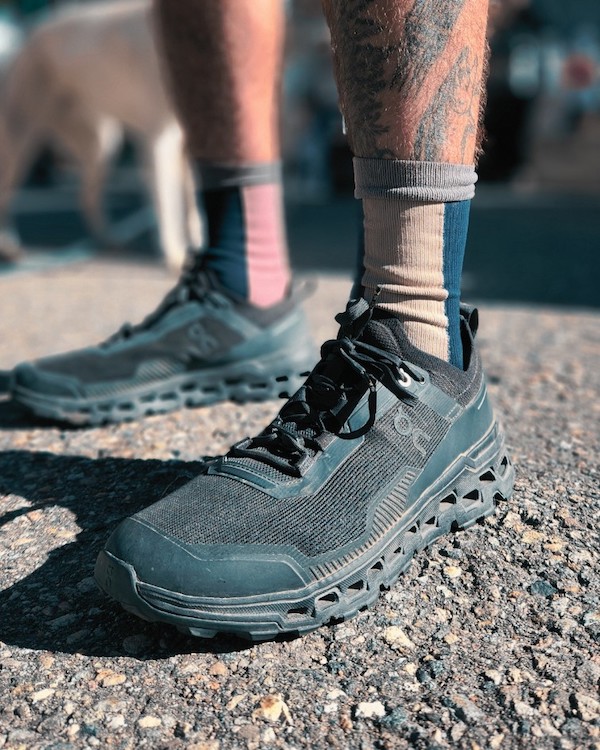
On Cloudultra 2
Typically, I don’t try to romanticize races when I talk about them; after all, there are easier, more pleasant things to do on a Saturday morning. But man, the A-Basin Cirque series was a really great time. The format and atmosphere was very inviting, even as a flat-lander, and I have no doubt that if you jump in one of these races you will almost definitely have a blast.
Sure, those hours on the StairMaster will seem boring in preparation, but it’s all worth it when you’re up there climbing switchbacks and bagging vert, as wide mountain vistas open up before you while your lungs pump for oxygen. Unlike an ultra, these races can be completed (and more crucially, recovered from) in the span of a weekend. Of course, ultras are awesome for a reason, but if you’re like me and don’t have a ton of PTO to throw around for ultra-distance race weekends, I would strongly consider giving this format consideration if you are looking to invest some time and money into a big race out West. Sure, the mileage may not be maxed-out, but the fun levels cannot be matched.
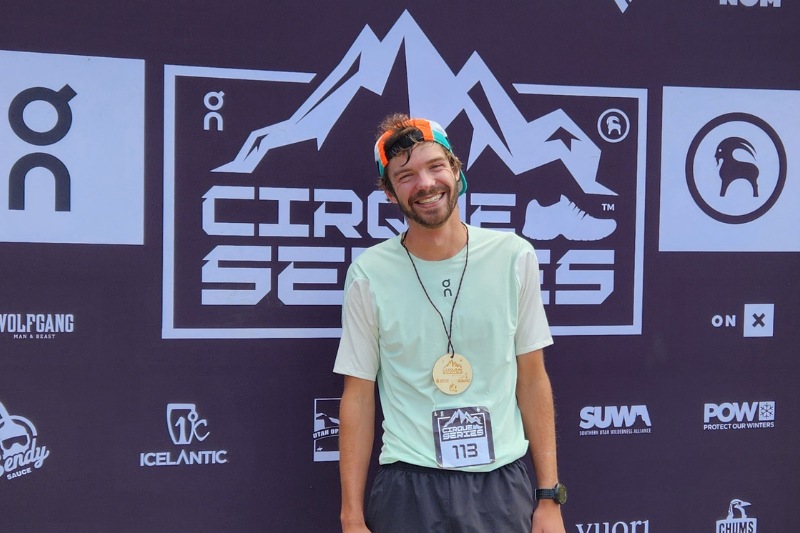
Second place in the Sport division!
I want to give a massive thank you to everyone involved with this opportunity. To Julian and the crew at Cirque series, thank you for seeing a need in the US racing scene, having an idea, and making that idea a reality. These races are an outrageous success, and really highlight the US short course racing scene without the narrow field sizes that we’ve grown accustomed to for races run on more protected land.
Thank you to Eli Stillman and the On crew for stoking the hype at these races with sponsorship and gear. Moving in the mountains is more fun when you have quality (and good-looking) equipment to do it in, and it’s really exciting to see a brand that is growing so rapidly in popularity investing into trail racing in the US.
Also, thank you to Taylor and his family for housing us and providing race-day transport through the most scenic of routes. Lastly, thank you most of all to my wife Mary for the endless encouragement and support during this brief but wild weekend adventure, which happened to be situated right in between double 12-hour shifts on the nursing floor.
So to answer my original questions I posed way too many sentences ago (“Is it actually worth flying out West for a weekend to try one of these things?”): Yes, these races are wildly fun, and if you have the chance to escape for a weekend and run one, do it! You won’t be disappointed.
Want to learn more about the Cirque Series or find the closest race to you? Check it out at cirqueseries.com.
If you’re interested in trying out On, the title sponsor of Cirque Series, check out their shoes at on-running.com or at the shop links below.
Have something to say? Leave a Comment

Taylor Bodin is a trail and ultra runner living in Estes Park, Colo., with his wife and daughters. Trail running is pretty much the only hobby he can manage right now and loves it. Every so often, he will pop off a race or FKT attempt because competition is pure and the original motivator for him getting into running anyways. When not running, Taylor is a 1st grade teacher, running coach (track & field, Cross Country, and Trail/Ultra athletes), and volunteers at his church.
More from Taylor
An engineer living with his wife and cat in Birmingham, Ala., Michael loves chill morning runs in the neighborhood, but especially enjoys soaking up long miles of technical southeast singletrack. Occasionally, he’ll get a racing itch and actually string together some “organized” training for a trail race or FKT. In his free time, Michael enjoys books, backpacking, and hanging out with friends.
More from Michael
